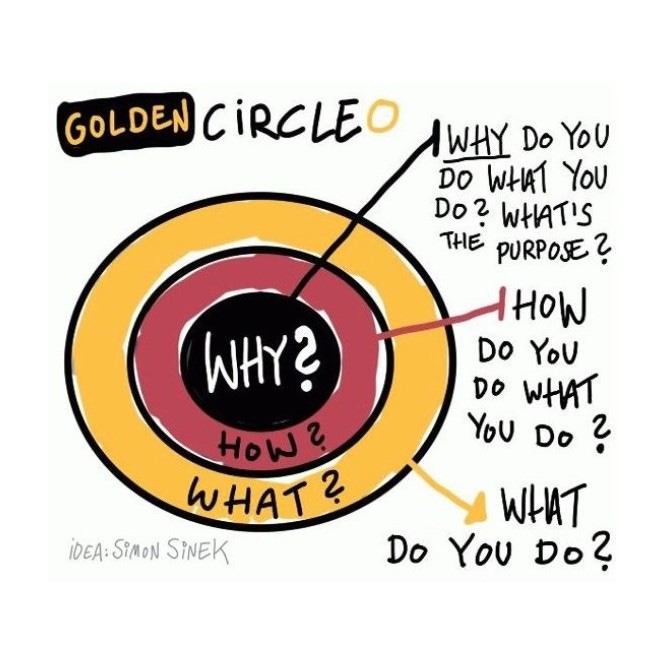The Power of Why
Entrepreneurs would rather work 16 hours a day for themselves, than 8 hours for someone else. Why would anyone do that? I'll tell you why I did. Why would you?
Whatever your reason, that's your Why. Even if you can't put it into words, yet. It’s not to make money. Profit and cashflow are not a purpose. They are results. Dig deep. Why do you get out of bed in the morning? Who needs you to? Why do you put in more hours than you should?
Let’s explore what Simon Sinek taught us in his bestselling book, Start With Why
Why do you love your loved ones? Hard to say, right? It just feels right. That’s because our limbic brain is responsible for our feelings. And our decision-making. But it has no capacity for language. Your ability to explain your decisions exists in a different part of the brain.
I didn't have a detailed business plan when I bought the company I own now. I was able to operate without one because I don't have any partners or investors. I only work with a couple employees and have no plans to scale. I had enough experience to let my limbic brain call the shots as we got started. I trusted my gut. But as a business coach, I get to help entrepreneurs with less experience build, grow, and scale businesses with more than a couple people on their team.
Those Who Know Why, Need Those Who Know How
As the owner of your business, you own your company’s Why. It’s your job to make sure everyone on your team is inspired by your Why. And knows How you expect them to bring it to life. Your business is your megaphone, for better or worse, so you need to be clear on your Why. Exactly what message do you want your employees to amplify?
Your company's HOWs are the actions your team takes to bring your WHY to life (e.g. operations, systems, and processes). Your WHATs are the results of those actions, including everything from your culture to your marketing messages to the products you sell.
For your company to reach its potential, your WHATs must be consistent with your HOWs which must be consistent with your WHY. That alignment is the only way the world will ever know what you truly believe. If you’re not consistent, they won’t know. Or worse, they won’t believe you. And then you’ll be stuck competing on price.
How to Influence Human Behavior
You have 2 options: manipulation or inspiration. The first leverages sticks and carrots (like price) to create “transactions.” You can manipulate your customers into repeat transactions, but that’s not loyalty. Loyalty is when a customer or employee chooses you in spite of your competitors’ carrots.
People like to work with people who share their beliefs. When we can see that a company's values and beliefs are consistent with our own, most of us will go out of our way to use that company's products and services. Same is true for your employees. That's inspiration.
Your customers can only see what you believe (i.e. your Why) through your products and services. And by How you do business. Focus on attracting and serving people who believe what you believe. In your sales and marketing messages, tell your target audience Why you do what you do, even if it’s only subliminal.
Don’t try to be all things to all people.
The Power of Why
Samuel Langley was well-funded by the government and had a team of specialists to invent the first airplane. Langley wanted to be first. He wanted to be rich and famous. That was his Why. That’s also why he failed.
The Wright brothers made the first controlled, sustained flight of an engine-powered aircraft on December 17, 1903. Just the two of them working from their little bicycle shop. They had a bigger, better Why.
Southwest Airlines' original WHY was to be “the champion for the common man.” They did this by being “cheap, fun, and simple” (HOW). Which resulted in their legendary culture, people, and marketing messages (WHAT), and 47 profitable years in a row. Most of their major competitors went bankrupt during that same period.
Why Did I Work 16 Hours a Day?
When I left my father's business to start my first company, no one thought I would succeed, including my then-wife. She opted out. We had two small kids and almost $0 net worth at the time. It was hard, but five years later I made my first million and never looked back. And I've been happily re-married for 20+ years. 😊
What was my Why? I had something to prove. To myself and my family. And, if I'm honest, my ex-wife. I helped a lot of people along the way, but that wasn't my Why at the time. I'm not proud of that, but it's the truth. Having a chip on your shoulder is a common, sometimes effective, motivator.
What's My Why Now?
I’m striving to reach my potential in all the PERMA+ elements of wellbeing. That’s why I write these articles. And why I’m a business coach (and soon-to-be adjunct business professor) — to help other business owners and aspiring entrepreneurial leaders reach their potential.
As I discuss in this article about James Clear’s book Atomic Habits, the person who learns the most in any classroom is the teacher. Stephen Covey taught me the same thing. Covey inspired me to teach The 7 Habits of Highly Effective People to one of my first teams 30+ years ago.
You can read more about my Why here.
The Joy of Striving is brought to you by Scaling Profit, where my core purpose is to help you build a Sustainable 7 figure business. Check it out if you’re curious.



